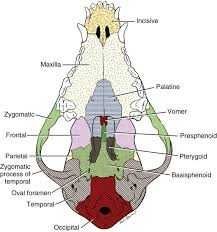![]()
![]()
![]()
Use LEFT and RIGHT arrow keys to navigate between flashcards;
Use UP and DOWN arrow keys to flip the card;
H to show hint;
A reads text to speech;
18 Cards in this Set
- Front
- Back
|
The three types of bone cells |
Osteoblasts, osteocytes, osteoclasts |
|
|
The four basic bone shapes |
Long, short, flat, irregular |
|
|
The two major sections of the skeleton |
Axial and appendicular |
|
|
Three classes of joints |
Fibrous, cartilaginous, synovial |
|
|
Elevated blood calcium results in increased activity by which type of bone cells? |
Osteoblasts (cells remove calcium from the blood and store or in the bone) |
|
|
Bones have two types; light and spongy ____ bone and dense, heavy ___ bone. |
Cancellous and Compact |
|
|
The most common type of bone marrow in older animals |
Yellow |
|
|
True/false: Yellow marrow does not produce red blood cells |
True: red marrow produces blood cells. yellow marrow aids in fat storage and cartilage production. |
|
|
The area of a bone where a blood vessel may pass through A. Canciculi B. Foramen C. Fossa |
B. The Foramen (the fossa is the indented attachment point of muscles and tendons) |
|
|
Of the bones in the skull, only the ____ is connected by a movement joint |
Mandible |
|
|
The bones is the ear include the incus, the malleus, and the ____. A. Maxillary B. Stapes C. Ethmoid |
The stapes |
|
|
The bone that separates the nasal passages to the left and right. A. Vomer bone B. Palatine bone C. Turbinate/ nasal conchae |

The Vomer bone separates the nasal cavity. |
|
|
The most noticeable difference in vertebrae between a cat and dog would be found in the ___ section of vertebrae. |
Coccygeal (coccygeal vertebrae can vary between species depending on the length of the tail) |
|
|
The ____ vertebrae are characterized by their tall spinous processes and articular facets. A. Lumbar B. Cervical C. Thoracic |
C. Thoracic (the lateral facets form joints with the animal's ribs) |
|
|
The three classifications of joints: |
Synovial, cartilaginous, fibrous |
|
|
True/false: cartilaginous joints are immovable and united by fibrous tissue. Found in the skulls and splint bones |
False: fibrous joints are united by fibrous tissue |
|
|
The ___ is the fibrocartilagenous joint structure helps to absorb shock. A. Joint capsule B. Synovial membrane C. Meniscus |
Meniscus (found between tibia and femur) |
|
|
The antebrachium of the appendicular skeleton, is more commonly known as the ____. |
Forearm |

